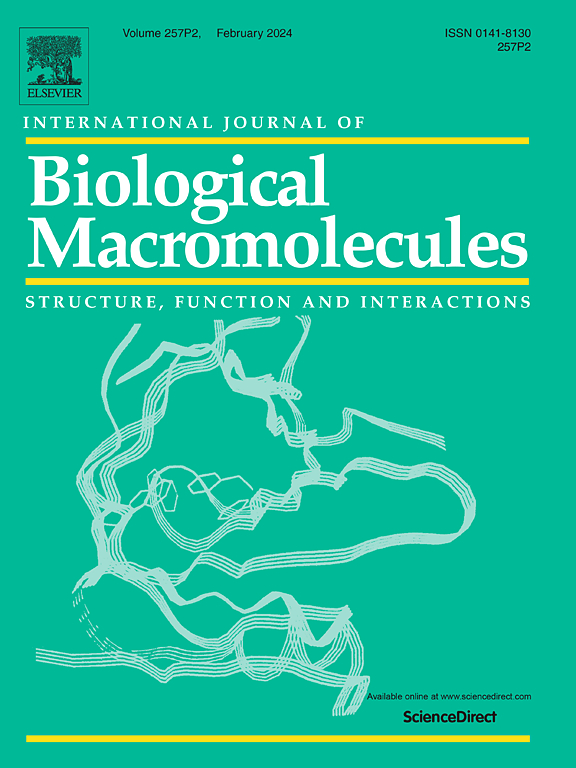Improving the performance of polylactic acid/polypropylene/cotton stalk fiber composites with epoxidized soybean oil as a high efficiency plasticizer
IF 7.7
1区 化学
Q1 BIOCHEMISTRY & MOLECULAR BIOLOGY
International Journal of Biological Macromolecules
Pub Date : 2024-12-01
DOI:10.1016/j.ijbiomac.2024.137814
引用次数: 0
Abstract
Polylactic acid (PLA) can serve as a biodegradable alternative to traditional petroleum-based plastics, but its poor impact resistance and high production costs limit its applications. In this study, different contents of epoxidized epoxy soybean oil (ESO) were added as plasticizer to melt blend with polylactic acid (PLA), polypropylene (PP) and cotton stalk fiber (CSF), examining its impact on the mechanical properties, thermal stability, microstructure, and crystallization behavior of the blends. The results indicated that ESO reacted with PLA and CSF to form branched polymers and microgels. With increasing ESO content, the blends exhibited increased initial thermal decomposition temperature, impact strength, and elongation at break, while stiffness, maximum decomposition rate, and crystallinity decreased. When the mass ratio of CSF to ESO was 2:1, the notch impact strength and elongation at break of PLA/PP/CSF/ESO blends were 1.63 times and 1.98 times higher than those of PLA/PP/CSF blends, respectively. Moreover, a reduction in surface grooves of CSF and formation of a gel layer were observed. Importantly, this study opens an effective new pathway for the utilization of waste natural fibers and the widespread application of biodegradable composite materials, contributing to environmental protection, resource conservation, and cost reduction.
用环氧大豆油作为高效增塑剂提高聚乳酸/聚丙烯/棉秆纤维复合材料的性能。
聚乳酸(PLA)是一种可生物降解的塑料,可替代传统的石油基塑料,但其抗冲击性差、生产成本高,限制了其应用。本研究将不同含量的环氧化环氧大豆油(ESO)作为增塑剂添加到聚乳酸(PLA)、聚丙烯(PP)和棉杆纤维(CSF)的熔融共混物中,考察其对共混物机械性能、热稳定性、微观结构和结晶行为的影响。结果表明,ESO 与聚乳酸和 CSF 反应生成支化聚合物和微凝胶。随着 ESO 含量的增加,混合物的初始热分解温度、冲击强度和断裂伸长率增加,而刚度、最大分解率和结晶度降低。当 CSF 与 ESO 的质量比为 2:1 时,PLA/PP/CSF/ESO 共混物的缺口冲击强度和断裂伸长率分别是 PLA/PP/CSF 共混物的 1.63 倍和 1.98 倍。此外,还观察到 CSF 表面沟槽的减少和凝胶体层的形成。重要的是,这项研究为废弃天然纤维的利用和可生物降解复合材料的广泛应用开辟了一条有效的新途径,有助于保护环境、节约资源和降低成本。
本文章由计算机程序翻译,如有差异,请以英文原文为准。
求助全文
约1分钟内获得全文
求助全文
来源期刊
CiteScore
13.70
自引率
9.80%
发文量
2728
审稿时长
64 days
期刊介绍:
The International Journal of Biological Macromolecules is a well-established international journal dedicated to research on the chemical and biological aspects of natural macromolecules. Focusing on proteins, macromolecular carbohydrates, glycoproteins, proteoglycans, lignins, biological poly-acids, and nucleic acids, the journal presents the latest findings in molecular structure, properties, biological activities, interactions, modifications, and functional properties. Papers must offer new and novel insights, encompassing related model systems, structural conformational studies, theoretical developments, and analytical techniques. Each paper is required to primarily focus on at least one named biological macromolecule, reflected in the title, abstract, and text.
文献相关原料
公司名称
产品信息
阿拉丁
Epoxidized soybean oil

 求助内容:
求助内容: 应助结果提醒方式:
应助结果提醒方式:


